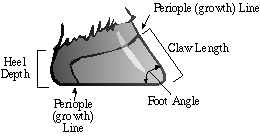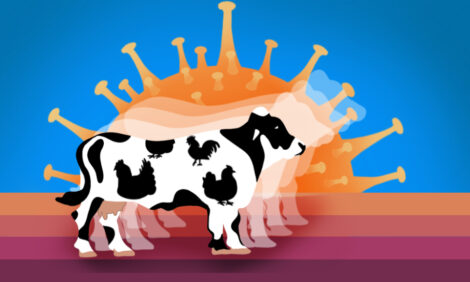



Improved Foot Health: Genetic and Management Implications
By Bennet G. Cassell; Extension Dairy Scientist, Genetics and Management, Virginia Tech. Table of Contents
Table of ContentsIntroduction
Genetic control when foot shape is carefully measured
Studies using classification data
Using genetic evaluations for foot structure
Management techniques
Summary
Introduction
Today's dairy cow faces very different environmental conditions from cows of years ago. High energy rations, confinement on wet concrete, constant exposure to corrosive conditions, and perhaps even increased body size are all contributors to poorer foot health. Any genetic change for foot structure that has occurred through the years, even positive change, probably has had very little effect on foot health. This guideline presents recent research results about the role of genetics in foot structure and proposes alternatives to heavy emphasis on foot shape in sire selection.Genetic control when foot shape is carefully measured
Traits related to foot structure are difficult to measure by visual appraisal. The most intensive research trial ever conducted using measured foot traits was done in six state institutional herds in North Carolina. The herds were bred, fed, and managed using the same methods used in Virginia today. Figure 1 Hoof characteristics that can be evaluated by actual measurements |
Compasses, protractors, and rulers were used to measure claw length, heel depth, and angle of the front of the foot to the ground (Figure 1) on several thousand dairy cows across a 15-year period. The author had personal experience in collecting some of the data during a Ph.D. program in the early 1980's. Collecting hoof measurements is a hot (or cold), hard, dirty business, which is why objective data are rare.
Choi and McDaniel (J. Dairy Sci. 76:1989) summarized data from the project in 1993. Heritability of foot angle was 18 percent, claw length was 25 percent heritable, and heel depth was 7 percent heritable. A trait with heritability of 18 percent can be changed through selection, though more slowly than a trait like milk production (25 percent heritability). Heritability of claw length shows that it could be changed about as quickly as milk production through sire selection, but little would be accomplished by selecting to change heel depth.
Has selection for higher milk yield changed genes for foot conformation through a "correlated response" mechanism? The cows in the North Carolina study had been under heavy selection pressure for higher milk yield. Choi and McDaniel looked at relationships of objectively evaluated hoof measurements and other traits in dairy cattle (Table 1).
| Table 1. Genetic correlations between measured foot traits and other characteristics of dairy cows in North Carolina institutional herds | |||||
| Trait | Foot angle | Claw length | Heel depth | ||
|
Milk
|
.01 | .18 | -.12 | ||
|
Fat
|
-.40 | .24 | -.06 | ||
|
Days Open
|
-.44 | .26 | .59 | ||
|
Survival to 5 yrs
|
.21 | -.01 | .36 | ||
|
Age at culling
|
.87 | -.34 | .47 | ||
Genetic correlations show that selection for increased milk yield would not affect foot angle, but improved fat yield would cause lower foot angles. Milk and fat yields are controlled by many of the same genes, so we would not expect the genetic relationship with foot angle to be very different for milk and fat. Probably, selection for improved production will increase frequency of some undesirable genes for foot angle. Claw length would increase genetically with selection for higher yields and heel depth would decline slightly. All of these relationships are undesirable. Steeper foot angles and shorter claw length were associated with fewer days open, greater survival to five years of age, and older ages at culling, all desirable results. Deeper heels meant more days open, but increased longevity.
To producers, these relationships mean that selection to improve feet will reduce genetic progress for production. On the other hand, unrestricted selection to improve milk yield might cause enough genetic deterioration in foot angle to be a problem, especially since some reproductive functions also suffer with deterioration of foot structure.
Studies using classification data
Farmers use genetic evaluations based on classification scores rather than research data. Heritabilities and relationships between some linear type traits from Holstein type classifications and lifetime performance traits are in Table 2. These results are from Weigel, et al (J. Dairy Sci. 78:639) at Virginia Tech in 1993. Low scores for foot angle indicate low angles (flat feet) which are considered less desirable. Low scores for rear legs side view indicate straight hocks, high scores indicate sickled hocks, and intermediate values are considered best.
The heritability for foot angle is 10 percent using classification data, meaning that progress for foot angle using Holstein linear trait data will be slower than if actual measurements were used. The heritability of legs side view is 16 percent, indicating that some changes could be achieved through sire selection. However, since legs side view is "best" at an intermediate value, selection of an optimum mate cannot be in the same direction for all cows. If legs side view has sufficient economic value to be included in a selection program (a conclusion I would question based on information to follow), we should use sire evaluations for legs side view only to assign mates to bulls chosen for their superiority in other traits like production where high production is always valuable.
Genetic relationships between feet and leg traits and lifetime profit or months in milk by 84 months of age (USDA's "Productive Life") were near zero. Genetically, feet and leg traits have little relationship to lifetime profit or herdlife. Selection to improve either feet or legs will be frustrating because progress will be slow and very little will be accomplished to improve lifetime profitability. If selection pressure on yield is sacrificed to improve feet or legs, the impact on profitability would be negative.
| Table 2. Heritabilities and genetic correlations of linear type traits and lifetime performance characteristics of classified Holstein cows | |||||
| Genetic correlation of linear trait with | |||||
| Linear trait | Heritability | Lifetime net income | Months in milk by 84 months of age | ||
| Legs side view | .16 | .05 | -.01 | ||
| Foot angle | .10 | -.07 | .08 | ||
Using genetic evaluations for foot structure
Selection to improve milk production while ignoring feet will produce a gradual decline in merit for foot structure. The proper reaction, however, is NOT to eliminate AI bulls with lower evaluations for foot angle from a breeding program. This approach will reduce genetic gain for production, will not change foot structure appreciably, and cannot be justified economically. A quote from Choi and McDaniel is appropriate advice. "Given their antagonistic relationships with milk yield but favorable ones with survival, hoof traits must be used in a selection index to be effective in genetic improvement for economic efficiency."Dairy producers can make wise use of genetic evaluations for feet by selecting service sires using the NET MERIT INDEX published by USDA with each sire summary. NET MERIT is explained in detail in VCE Publication 404-088, Net Merit. Foot angle and other linear type traits are used to help predict productive life which is combined with genetic evaluations for production and somatic cell score in the NET MERIT index.
Management techniques
Use management to improve foot health. Better herd management can improve foot health for cows currently in the herd. Sire selection only affects generations yet to be born. The following recommendations are general. Complexity of individual herd management problems prevents more specific general advice. A knowledgeable dairy veterinarian or Extension specialist with expertise in physiology or nutrition are good sources for specifics.1. Nutrition: Providing proper rations for lactating, close up dry cows, and springing heifers is probably the best single management practice producers can adopt to reduce the incidence of chronic foot problems. Laminitis is an inflammation of the tissues that produce and maintain the foot that may result in a separation of the hoof wall from the bony structure of the hoof. Modern dairy management practices have caused laminitis to become a major problem for many dairies. Many cases of laminitis are caused by a sudden change from a low energy dry lot feeding program to the energy dense rations needed for top production. A period of adjustment to the new ration prior to calving or introduction into the high group can stop or reduce the severity of laminitis. Inadequate fiber at any stage of development or production can also cause laminitis.
We may have bred cows more disposed to laminitis by selection for higher milk production. High producers have good appetites and usually are aggressive feeders. Such gluttons (profitable gluttons!) may be more prone to laminitis than cows of forty years ago. They might be quicker to consume large amounts of high energy rations, creating the acid rumen conditions which can lead to laminitis.
2. Facilities: Conditions that discourage cows from lying down create unnecessary stress to foot tissues and can lead to or worsen hoof damage from laminitis. Manage cows so that they have clean, dry hooves for as much of the day as possible. Constant confinement on manure covered concrete lots has caused many more foot problems than bulls with inferior genetic merit for foot structure. Where possible, clean, well drained, grass-covered exercise lots should be used. The good foot health of those cows of forty years ago was enhanced by walking through pasture where hooves were cleaned and dried naturally. Footbaths can help in confinement systems, but require maintenance and have generated some environmental concerns from the solutions they contain. Keep freestalls clean and comfortable. Encourage the cow to get her weight off her feet and let them dry out.
3. Foot trimming: Plan to trim feet on at least a few cows at regular intervals. Some problem cows will always need this special attention, but the investment is well worth making if an extra calf or two is born to highly productive animals.
Summary
It is easy to blame the bull for poor feet in a herd, but what is usually required is a good dose of improved management. Selection indexes should be used to incorporate foot angle into herd breeding programs in an economically realistic fashion. One widely available index that includes a sire's genetic merit for foot angle is NET MERIT. Top sires for NET MERIT transmit the best combination of superior genes for production, longevity, somatic cell score and conformation traits for the management systems present in most dairy herds.June 1996



